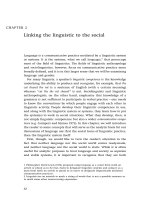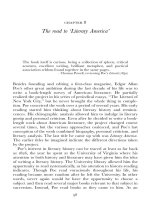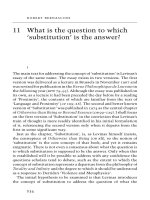The road to Literary America
Bạn đang xem bản rút gọn của tài liệu. Xem và tải ngay bản đầy đủ của tài liệu tại đây (73.91 KB, 14 trang )
chapter 8
The road to `Literary America'
The book itself is curious, being a collection of spleen, critical
acumen, excellent writing, brilliant metaphor, and poetical
association seldom found together in the same pages.
± Thomas Powell, reviewing Poe's Literati (1850)
Besides founding and editing a ®rst-class magazine, Edgar Allan
Poe's other great ambition during the last decade of his life was to
write a book-length survey of American literature. He partially
realized the project in his series of periodical essays, ``The Literati of
New York City,'' but he never brought the whole thing to comple-
tion. Poe conceived the work over a period of several years. His early
reading started him thinking about literary history and reminis-
cences. His chirographic analysis allowed him to indulge in literary
gossip and personal criticism. Even after he decided to write a book-
length work about American literature, the project changed course
several times, but the various approaches coalesced, and Poe's last
conception of the work combined biography, personal criticism, and
literary analysis. The last title he came up with was Literary America.
The earlier titles he imagined indicate the different directions taken
by the project.
Poe's interest in literary history can be traced at least as far back
as 1826, the year he spent at the University of Virginia where his
attention to both history and literature may have given him the idea
of writing a literary history. The University library allowed him the
opportunity to read systematically, as his attention to history-reading
indicates. Though Poe read voraciously throughout his life, his
reading became more random after he left the University. In other
words, never again would he have the opportunity to choose a
subject and then read several major books relevant to that subject in
succession. Instead, Poe read books as they came to him. As an
98
editor, he read widely, yet the only pattern his reading followed was
the publication order of the books he reviewed.
Other early reading may have in¯uenced Poe's attitude toward
literary biography. Reviewing Augustus Baldwin Longstreet's Georgia
Scenes, Poe recalled the long-standing tradition of character-writing
and suggested, ``In regard, especially, to that class of southwestern
mammalia who come under the generic appellation of `savagerous
wild cats,' he is a very Theophrastus in duodecimo. But he is not the
less at home in other matters. Of geese and ganders he is the La
Bruye
Á
re.''
1
Poe's offhand references suggest his familiarity with
Theophrastus' Notationes morum, which he may have read in his
adolescence at Joseph Clarke's Richmond school. Poe also knew the
work of Theophrastus' seventeenth-century editor, Jean de La
Bruyere, who added many new sketches in his edition of Theo-
phrastus' Characters, or The Manners of the Age. Poe's critical dictum
that the death of a beautiful woman made the most appropriate
artistic subject may owe a debt to La Bruye
Á
re, who wrote that a
beautiful face was the most beautiful of sights. These writers gave
Poe a pattern to follow, yet the biographical sketches he would write
do not follow the traditional pattern of characters. Instead of
describing speci®c personality-types, Poe sought to characterize real
people important to American literature. Furthermore, his sketches
lack the polish and structure of traditional character sketches. The
essays he completed for his study of American literature have a
rough, catch-as-catch-can quality. Nevertheless, Poe's eventual deci-
sion to subdivide his work into brief sections, each devoted to a
single author without additional narrative to connect them, and his
emphasis on the personal characteristics of his subjects reveal his
debt to the character-writers.
At the Southern Literary Messenger, Poe also had the chance to read
many memoirs and reminiscences, and these helped shape the
direction of his literary study, too. Reviewing B. B. Thatcher's Traits
of the Tea Party, for example, Poe wrote, ``Reminiscences such as the
present cannot be too frequently laid before the public. More than
anything else do they illustrate that which can be properly called the
History of our Revolution ± and in so doing how vastly important do
they appear to the entire cause of civil liberty?''
2
Reminiscences
could capture the ¯avor of the times in a way which historians of
times past could not. Similarly, Poe saw John Quincy Adams's
personal recollections gave his Jubilee of the Constitution value: ``What
The road to `Literary America' 99
Mr.Adamshasthusdonecouldnotbesowelldone,perhaps,byany
man living. The circumstances by which he has been surrounded
from his boyhood ± his intimate connexion, private and public, with
the leading men of the Revolution ± his long continued political
career ± his industrious habits of observation ± his personal identi®-
cation for nearly half a century with the interests of his subject ± all
had conspired to assure us that this subject would be skillfully
handled, and the discourse itself assures us that, essentially it is.''
3
Poe found Adams's discussion of the private world of the founding
fathers especially worthwhile. His appreciation of Thatcher and
Adams shows that he preferred personal reminiscence over historical
reconstruction. This perference would shape his approach to writing
literary history.
The Autobiography of Benvenuto Cellini reinforced the value Poe
attached to reminiscences. Not only was autobiography useful for
understanding the lives of writers, it also helped readers understand
the times in which they lived and the people they knew. Reviewing a
new edition of Cellini's Autobiography, Poe stated that the author's
intimacy ``with all the noted men of his very remarkable age'' and
his contact with the day's intrigues, both great and petty, made his
book worth reading in later times. Cellini ``felt keenly ± in fact his
excessive sensibility amounted to madness ± and he has depicted his
feelings, not less than his thoughts and deeds, with a hand of a
profound moral painter.''
4
The personal slant Cellini put on the men
and manners of his time gave Poe a precedent for his own personal
interpretation of the men and manners of mid nineteenth-century
America. Poe's description of Cellini's work could almost be applied
to his own, for the literary sketches he completed describe the
notable writers of his day as well as their contact with the day's petty
intrigues.
Poe knew well Isaac Disraeli's works: Amenities of Literature, Curios-
ities of Literature,andMiscellanies of Literature. He referred to Disraeli
multiple times and plundered his works to ®ll the odd corners of
magazines he edited. Disraeli showed Poe that a work of literary
history need not be organized chronologically to have value. As Poe
stated, the contents of Disraeli's Miscellanies ± facts, anecdotes,
literary legends, and miscellaneous information ± were ``marshalled
together here in disorderly array, pushing, jostling, and crowding
each other until they remind one of Falstaff 's valorous regiment, or
a militia training in a midland county,'' yet they nevertheless
100 Poe and the printed word
embodied ``a vast amount of out-of-the-way intelligence, interesting
to the general, but absolutely necessary to the literary reader.''
5
Poe's
individual essays in ``The Literati of New York City'' would follow
no particular order. As he would explain, ``As any precise order or
arrangement seems unnecessary and may be inconvenient, I shall
maintain none. It will be understood that, without reference to
supposed merit or demerit, each individual is introduced absolutely
at random.''
6
The random order not only shows Disraeli's in¯uence,
it also re¯ects the random quality of Poe's own acquisition of
knowledge.
``autography''
The ®rst article Poe wrote that anticipated his ``Literary America''
project was the two-part ``Autography.'' He drafted it in or before
September 1835 and published it in the Southern Literary Messenger the
following year.
7
``Autography'' allowed Poe to do what he had
largely avoided doing in his critical notices. Taking his reviewer's
task seriously, Poe had avoided personal criticism for the most part
in the Southern Literary Messenger reviews. In ``Autography,'' however,
he conveyed his personal impressions of many contemporary authors
within a ®ctional framework. Fiction gave him more freedom to
combine criticism with literary burlesque, something he had planned
to do for the ``Tales of the Folio Club.'' The deliberate ®ction gave
him the freedom to provide his opinions about many contemporary
authors while standing behind a persona. The article was broken
down into short sections. After a made-up letter attributed to a real
author came a facsimile reproduction of his or her autograph, a brief
analysis of the writer's chirography, another letter, and so on. The
®ctional premise of ``Autography,'' however, did not suf®ciently mask
the truth behind it. After all, the autographs included as part of the
article were well-executed woodcut facsimiles of real signatures of
many authors known to the American reading public. All were living
save Chief Justice Marshall, who had died in July 1835, and William
Wirt, who had died the year before. The critical comments, though
told from the point of view of a literary persona, often came too
close to the truth for comfort. About Washington Irving, Poe wrote,
``Mr. Irving's hand writing is common-place. There is nothing
indicative of genius about it.''
8
Though directed at Irving's hand-
writing, there can be little doubt that Poe was attacking his published
The road to `Literary America' 101
writings as well. ``Autography'' represents Poe's ®rst attempt to use a
personal attribute to discern a writer's character. In the ``Literati''
essays, he would use a different personal attribute ± physiognomy ±
in much the same way that he used handwriting in ``Autography.''
``a chapter on autography''
Writing for Graham's Magazine in late 1841 and early 1842, Poe
contributed three more articles presenting and analyzing the auto-
graphs of prominent American authors. These articles, known
collectively under the general title, ``A Chapter on Autography,''
differed from the earlier ``Autography'' in several ways. First, Poe
dropped the ®ctional pretense and excluded the made-up letters. ``A
Chapter on Autography'' consists of a series of autographs, again
reproduced in woodcut, each of which is followed by a discussion. In
general, the discussions are lengthier than those in ``Autography,''
and they often go well beyond analyzing the signature. Many
provide biographical facts and indulge in literary gossip. The ®rst
item, describing Charles Anthon, ®lls nearly three pages in a
modern edition. Prior to analyzing Anthon's handwriting, Poe gave
a brief biography and mentioned his subject's remarkable scholarly
accomplishments. Discussing Anthon's chirography, Poe wrote a
virtual treatise on the scholarly life. In the third item, he described
Park Benjamin's writing style before he analyzed his handwriting.
Clearly, Poe no longer felt it necessary to disguise his critique of an
author's writing style as a critique of his chirography. By the time he
®nished the three-article series, Poe realized that his ambition was
outstripping his format. He wanted to do more than the autography
approach would let him. He continued to believe in the importance
of chirography and hoped to include autographs in Literary America,
but he began considering new ways to treat American authors.
a critical history of american literature
Among Poe's surviving letters, the earliest indication that he had
begun a book-length study of American literature occurs in a letter
to James Russell Lowell written in mid-1844. He explained, ``For
myself I am very industrious ± collecting and arranging materials for
a Critical History of Am. Literature.''
9
Though the idea of a body of
written works which together formed a distinct American literature
102 Poe and the printed word









